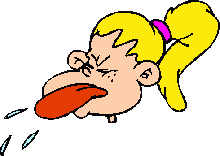Review Chez Punnett
 A Punnett Square shows all the possible genotype combinations resulting from a cross. The first set of alleles shows all possible allele combinationss contributed by the mother, and the second set shows possible types contributed by the father. We put the allele combination from the mother across the top and the allele combination from the father across the left hand side, but you could do it the other way around.
A Punnett Square shows all the possible genotype combinations resulting from a cross. The first set of alleles shows all possible allele combinationss contributed by the mother, and the second set shows possible types contributed by the father. We put the allele combination from the mother across the top and the allele combination from the father across the left hand side, but you could do it the other way around.
The Punnett Square for a mother that was Tt and a father that was Tt would yield approximately a 3:1 ratio of dominant to recessive phenotypes (and approximately a 1:2:1 ratio of AA, Aa, aa genotypes). Any other combination of parental genotypes can be figured out similarly, and will yield different ratios of genotypes and phenotypes (so don't assume that 3:1 is the answer to every problem!!!)
If you are trying to find the results of a cross involving 2 genes (i.e., fur AND teeth), then you need a bigger Punnett Square. With 2 genes, each parent can contribute 4 different allele combinations, and you need to list each of the 4 on the top (mother) or side (father) of the Punnett Square. For example, in a double hybrid cross (AaBb x AaBb):
This gives the famous 9:3:3:1 ratios for phenotypes. Again, note that this ratio ONLY holds if you specifically have a dihybrid cross. If you cross, say, AABb x Aabb, you will get a completely different ratio (8:8:0:0, in case you're curious). If you are asked to find the phenotypic ratios, check first whether the problem involves a dihybrid cross -- if not, always work out the Punnett Square.
All of these phenotypic ratios are approximate, because they're being produced by random processes -- just like you get approximately 50% heads when you flip a coin.
The probability of a given phenotype can also be found by using the laws of probability.
Learning outcomes:
You should now be able to:
- Explain the difference between an allele, a genotype and a phenotype
- Construct and use Punnett Squares for a single allele
- Construct and use Punnett Squares for a two allele pairs (a dihybrid cross)
- Use Punnett squares to determine the probability (ratio) of a particular genotype and phenotype in a given matching
If you want a printer-friendly version of this module, you can find it here in a Microsoft Word document. This printer-friendly version should be used only to review, as it does not contain any of the interactive material, and only a skeletal version of problems solved in the module.
Copyright University of Maryland, 2007
You may link to this site for educational purposes.
Please do not copy without permission
requests/questions/feedback email: mathbench@umd.edu